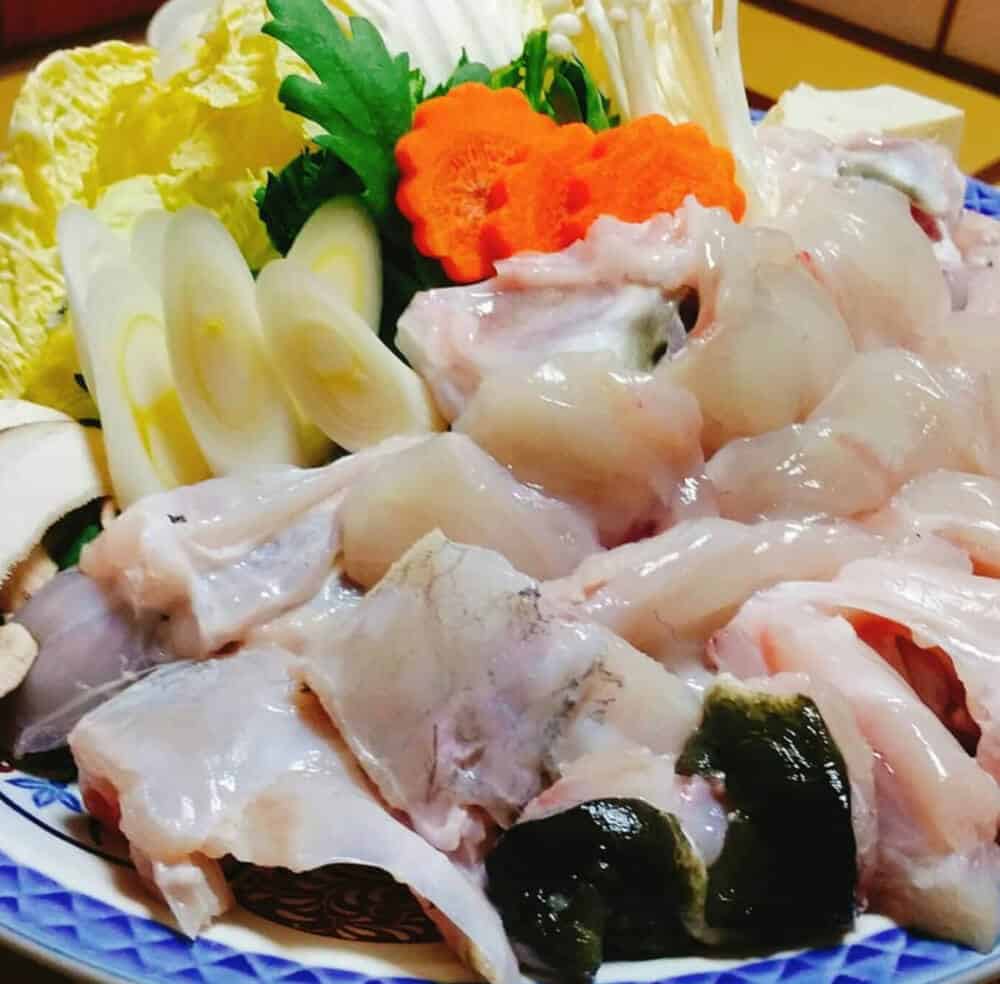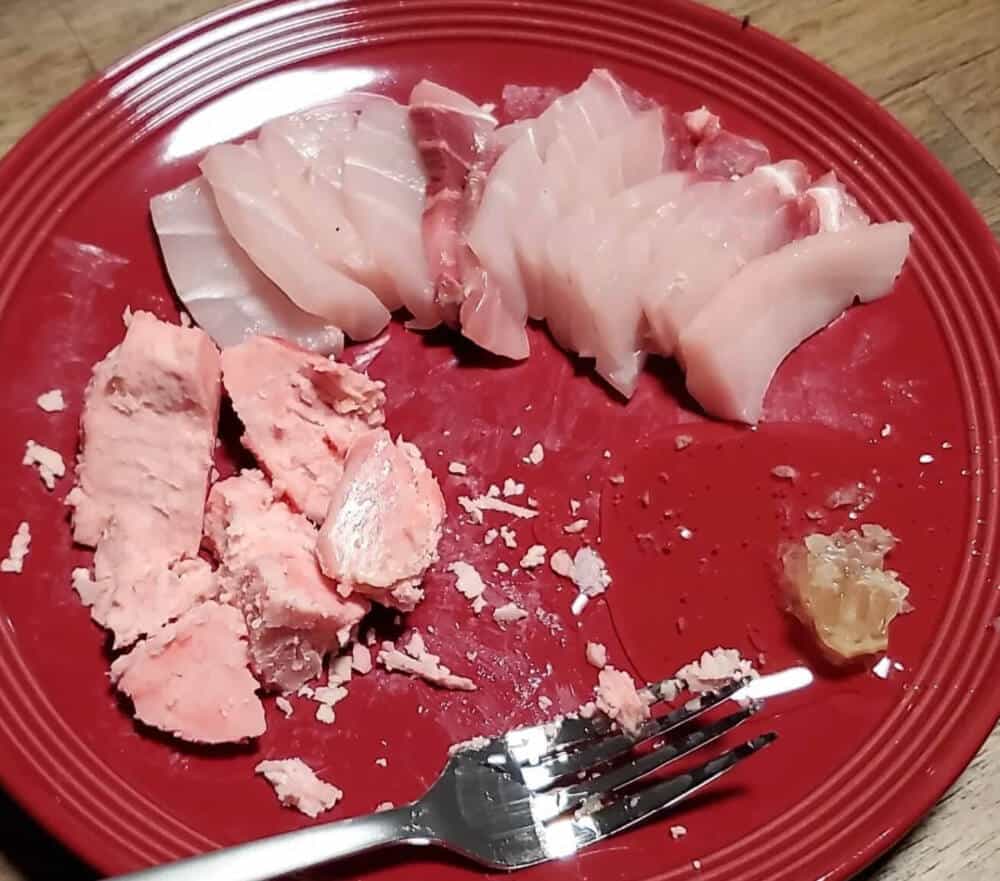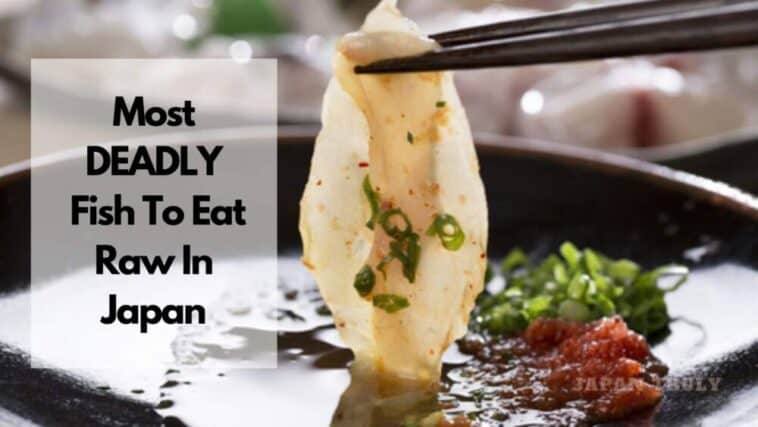Here are the most deadly fish to eat raw in Japan. Check it out!
Japan is renowned for its exquisite cuisine, especially its love for raw fish. However, not all raw fish are created equal, and some can pose serious health risks.
In this article, we explore the 14 most deadly fish to eat raw in Japan, shedding light on potential dangers lurking beneath the surface of this culinary delight.
Page Contents
Most Deadly Fish To Eat Raw In Japan
Fugu (Pufferfish)
Fugu, or pufferfish, is perhaps the most notorious among deadly Japanese delicacies. Its internal organs contain tetrodotoxin, a potent neurotoxin that can lead to paralysis and, in severe cases, death.

Chefs preparing fugu must undergo rigorous training and certification to ensure the safe removal of toxic parts.

Blowfish

Similar to fugu, blowfish carries the risk of tetrodotoxin poisoning. Chefs meticulously handle this fish to eliminate toxic parts, but the potential danger remains. Consumption of improperly prepared blowfish sashimi can result in paralysis and respiratory failure.
Stonefish
Known for its exceptional camouflage, the stonefish hides deadly venomous spines. Ingesting raw stonefish can lead to severe poisoning, causing intense pain, swelling, and in some cases, fatalities.
Tigerfish
Tigerfish, found in the Pacific Ocean, may contain toxins that can be harmful if consumed raw. Adequate preparation is crucial to neutralize potential risks associated with consuming this fish in its raw form.
Barracuda
Barracuda can carry ciguatera toxin, which causes food poisoning. The toxin accumulates in the flesh of the fish, making it dangerous to consume raw. Symptoms of ciguatera poisoning include nausea, vomiting, and neurological effects.
Raw Swordfish

While swordfish is a popular choice for sashimi, it may contain high levels of mercury. Excessive mercury intake can lead to health issues, particularly for pregnant women and young children. Consuming raw swordfish should be approached with caution.
Scombroid Fish (Tuna, Mackerel, and Mahi-Mahi)
Scombroid fish can produce histamine when not properly stored. Ingesting high levels of histamine can result in scombroid poisoning, causing symptoms such as flushing, headaches, and gastrointestinal distress.
Red lionfish
Though visually striking, the red lionfish carries venomous spines that can cause severe pain and discomfort. Eating this fish raw poses a risk of poisoning and should be avoided.
Tilefish
Tilefish, especially those from contaminated waters, may contain high levels of mercury. Raw consumption of tilefish can lead to mercury poisoning, affecting the nervous system and posing health risks.
Great white shark
Consuming raw great white shark may expose individuals to high levels of mercury and other potential contaminants. Due to its predatory nature, great white shark meat may harbor harmful substances that can impact human health.
Marlin
Marlin is another predatory fish that can contain elevated mercury levels. Raw consumption should be approached cautiously to prevent mercury-related health issues.
Escolar (Oilfish)
Escolar, often mislabeled as “white tuna” or “butterfish,” contains a wax ester that can cause gastrointestinal issues. Consumption of raw escolar may lead to an unpleasant condition known as escolar-induced diarrhea.
Shellfish (Oysters, Clams, and Mussels)
Shellfish can carry harmful bacteria, viruses, and toxins, particularly when harvested from contaminated waters. Consuming raw shellfish poses a risk of foodborne illnesses, including norovirus and hepatitis.
Raw Salmon
While salmon is a staple in Japanese cuisine, wild-caught salmon may carry parasites that can be transmitted to humans. Proper freezing and preparation techniques are essential to mitigate the risk of parasitic infections.
Tips On Eating Raw Fish In Japan
when it comes to consuming potentially risky raw fish in Japan, following these tips can help mitigate the associated dangers and enhance your dining experience:
- Choose Reputable Establishments:
Opt for well-established and reputable restaurants that have experienced chefs trained in the art of preparing potentially hazardous fish. Look for establishments with a history of safe food handling practices.
- Check Chef Credentials:
Ensure that the chef preparing your meal is licensed to handle and serve potentially dangerous fish like fugu. Government regulations in Japan require chefs to undergo rigorous training and obtain special licenses to serve certain types of fish.
- Ask About Sourcing:
Inquire about the sourcing of the fish. Choose restaurants that prioritize high-quality, fresh seafood from reliable and trusted suppliers. This reduces the likelihood of contamination or the presence of harmful substances.
- Avoid Unlicensed Vendors:
Steer clear of street vendors or unlicensed establishments that may not adhere to strict safety standards. Stick to well-regulated, licensed restaurants with a proven track record in handling and serving raw fish safely.
- Check for Transparency in Menu Descriptions:
Transparent menu descriptions are crucial. Restaurants should clearly communicate the risks associated with consuming certain raw fish, especially if they serve potentially hazardous species like fugu or blowfish.
- Be Informed About Local Regulations:
Familiarize yourself with local regulations and guidelines regarding the serving of certain fish. These regulations are in place to ensure the safety of consumers. Understanding them can help you make informed choices.
- Observe Food Safety Practices:
Ensure that the restaurant follows proper food safety practices, including hygiene, cleanliness, and adherence to storage and handling guidelines. This is crucial for preventing foodborne illnesses.
- Know Your Limits:
Recognize your own tolerance and susceptibility to certain toxins. If you have pre-existing health conditions or concerns, consult with a medical professional before indulging in potentially risky raw fish.
- Avoid High-Risk Species:
Exercise caution when considering fish known to be high-risk, such as fugu. If you’re not comfortable with the associated risks, opt for safer alternatives that are widely consumed without significant health concerns.
- Monitor Personal Hygiene:
Maintain good personal hygiene practices, such as washing your hands before eating. This can help prevent contamination and reduce the risk of foodborne illnesses.
- Be Mindful of Portion Sizes:
Some fish, like escolar, can cause digestive issues if consumed in large quantities. Be mindful of portion sizes, especially when trying less familiar varieties of raw fish.
- Know Emergency Procedures:
Familiarize yourself with emergency procedures in case of accidental ingestion of toxins. While the chances of this happening are low in well-regulated establishments, being prepared is always a prudent approach.
By following these tips and exercising caution, you can enjoy the unique and diverse world of raw fish in Japan while minimizing potential health risks.
Deadly Fish To Eat Raw In Japan: FAQs
Is it safe to eat fugu in Japan?
Yes, it can be safe to eat fugu in Japan, but it is crucial to choose reputable restaurants with licensed chefs trained to handle and prepare fugu safely. The potential risks associated with fugu are largely mitigated when proper precautions are taken.
Are there any precautions I should take when ordering blowfish sashimi?
When ordering blowfish sashimi, ensure that it is prepared by a skilled and licensed chef. The chef should follow strict protocols to remove any toxic parts of the fish, reducing the risk of tetrodotoxin poisoning.
What is the danger of consuming raw stonefish?
Raw stonefish can be dangerous due to its venomous spines. Ingesting this fish can lead to severe poisoning, causing intense pain, swelling, and, in extreme cases, fatalities.
Can tigerfish be safely consumed raw?
Consumption of tigerfish in its raw form may carry risks, as it can potentially contain toxins. Adequate preparation is essential to neutralize any potential dangers associated with eating this fish raw.
Is barracuda safe for raw consumption?
Barracuda may carry ciguatera toxin, making it unsafe to consume raw. Ciguatera poisoning can lead to symptoms such as nausea, vomiting, and neurological effects.
What precautions should be taken with raw swordfish?
Raw swordfish may contain high levels of mercury. To minimize the risk, individuals should approach the consumption of raw swordfish with caution, particularly pregnant women and young children.
What is scombroid poisoning, and how can it be prevented?
Scombroid poisoning can occur from consuming scombroid fish like tuna, mackerel, and mahi-mahi with elevated histamine levels. To prevent it, ensure proper storage and freshness of the fish and choose reputable establishments.
Why is red lionfish considered dangerous for raw consumption?
Red lionfish is dangerous due to its venomous spines, which can cause severe pain and discomfort. Consuming this fish raw poses a risk of poisoning and should be avoided.
Why can tilefish be unsafe when consumed raw?
Tilefish, especially from contaminated waters, may contain high levels of mercury. Raw consumption of tilefish can lead to mercury poisoning, affecting the nervous system.
Is it safe to eat raw great white shark?
Consuming raw great white shark may expose individuals to high levels of mercury and other potential contaminants. It is advisable to exercise caution due to the predatory nature of this fish.
What precautions should be taken with raw marlin?
Raw marlin may contain elevated levels of mercury. Individuals should approach the consumption of raw marlin cautiously to prevent mercury-related health issues.
Why is escolar considered risky for raw consumption?
Escolar contains a wax ester that can cause gastrointestinal issues. Consumption of raw escolar may lead to an unpleasant condition known as escolar-induced diarrhea.
Why are shellfish on the list of potentially deadly fish?
Shellfish like oysters, clams, and mussels can carry harmful bacteria, viruses, and toxins, particularly when harvested from contaminated waters. Raw consumption poses a risk of foodborne illnesses.
Is it safe to eat raw salmon in Japan?
While raw salmon is a staple in Japanese cuisine, wild-caught salmon may carry parasites. Proper freezing and preparation techniques are essential to mitigate the risk of parasitic infections when consuming raw salmon.
Conclusion
While Japan’s raw fish delicacies are a gastronomic delight, certain species harbor potential dangers. From the infamous fugu to mercury-laden marlin, it’s crucial to exercise caution when indulging in raw seafood.
Adhering to stringent preparation standards and choosing reputable establishments can ensure a safe and enjoyable culinary experience.
My writing focuses on the various aspects of Japanese lifestyle, from traditional tea ceremonies and flower arrangement to modern fashion trends and pop culture. Through my articles, I aim to share my passion for Japan and provide readers with a glimpse into the rich and diverse world of Japanese culture.
I believe that the key to understanding Japanese lifestyle is to appreciate the balance between tradition and innovation. While Japan has a rich cultural heritage that dates back centuries, it is also a country that is constantly evolving and embracing new ideas and technologies.
Whether you’re interested in learning about the latest fashion trends in Tokyo, or want to explore the ancient art of calligraphy, my writing will take you on a journey through the many facets of Japanese lifestyle. So join me as we explore the beauty and complexity of this fascinating culture together!





